Bulgaria’s attacking formation was predicated on the narrow front three’s positioning, with the intent of pinning Romania’s full backs and forcing them to defend 4v3. Both Stoichkov & Kostadinov remained in advanced positions during transition, each within the width of the 18 yard box. Penev served as a traditional target man, linking the play where possible.
Bulgaria’s midfield four would often contort into a box shape, with Balakov & Letchkov taking up more offensive roles. Letchkov & Balakov strong in dribbling 1v1 situations would carry the ball into the final third, therefore each had license to pull into wide areas to pick up possession & attack the flanks.
Yankov and Yordanov served to balance the attacks, starting deeper so being more aggressive in their forward passes. Balance also had to be provided in their defensive positioning, especially when Tsvetanov or Kishishev advanced forward like traditional full backs.
Bulgaria Starting X1
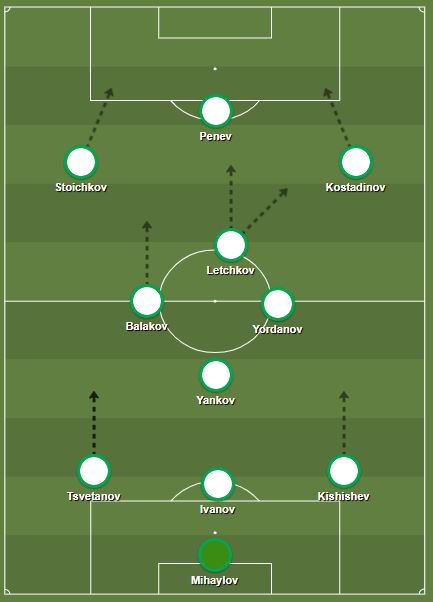
Romania’s default shape was a 433, however there were periods where Munteanu moving centrally and Lacatus going forward caused the overall shape to look more like a diamond 442.
Radiciou was a lot more active in this match dropping like a false 9 between the lines to link with Munteanu & Lupescu, while Lacatus & Hagi made movements beyond the striker to offer penetration.
Hagi’s free role gave him license to use his creativity and experience to find spaces in the Bulgaria set up. We found that he predominantly pulled into the inside left channel, with Lupescu attacking the inside right channel to offer balance in the middle of the field.
Popescu screened the space in front of the back line and covered for the advancing movement of Hagi and Lupescu. In possession he also served as the perfect entry point when building the game, acting as a pivot in front of the back two playing vertical and lateral passes.
Both full backs were very advanced, providing the sole genuine width in the game. At times this would contort the shape into 253 of sorts, with all three strikers moving centrally.
Romania Starting X1
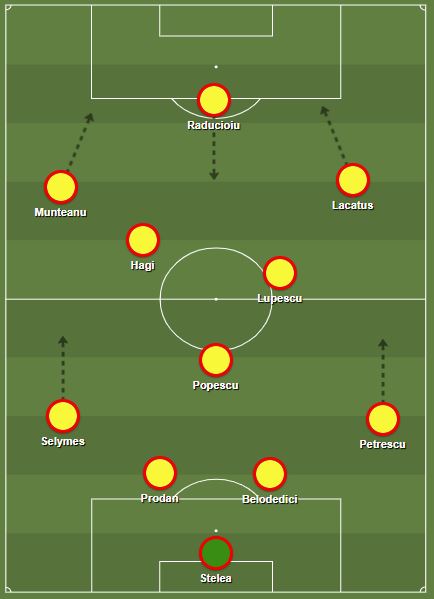
WHAT DO THE NUMBERS TELL US?

Value of Chances
xG Timeline:
Romania’s control of the game is evident in the timeline, as we see them creating attacks more regularity than their opponent. With that said given qualification was at stake in the game, there were two worrying dead periods in the match (30 – 50 & 68 – 88) that would lead us to question how they utilized their attack play.
Bulgaria’s early goal clearly gave them something to protect in this match, however the way in which they achieved this was certainly far from conventional. A steady attacking timeline from the Bulgarians, however it’s the quality of their chances that would solidify the performance.
Chance Quality:
In a similar vein to the opening game I think Romania will be disappointed at the quality of their chance creation overall. Only one “big chance” (A situation where a player should reasonably be expected to score) in this match and with it an array of speculative efforts that return truly little probability. Their quantity of efforts is commendable as it shows they are controlling the game enough & entering the opponents final third, however it’s the lack of craft they are showing to increase their per shot xG ratings that is coming back to bite them.
The context of Bulgaria’s performance is framed by the early goal, as it altered their strategy significantly, however they like Romania had many shots from distance that offered little threat. They did create 2 big chances in the game, and did show just enough quality to probably be satisfied, with over half their xG coming from shots on target.
Type of Chances Created
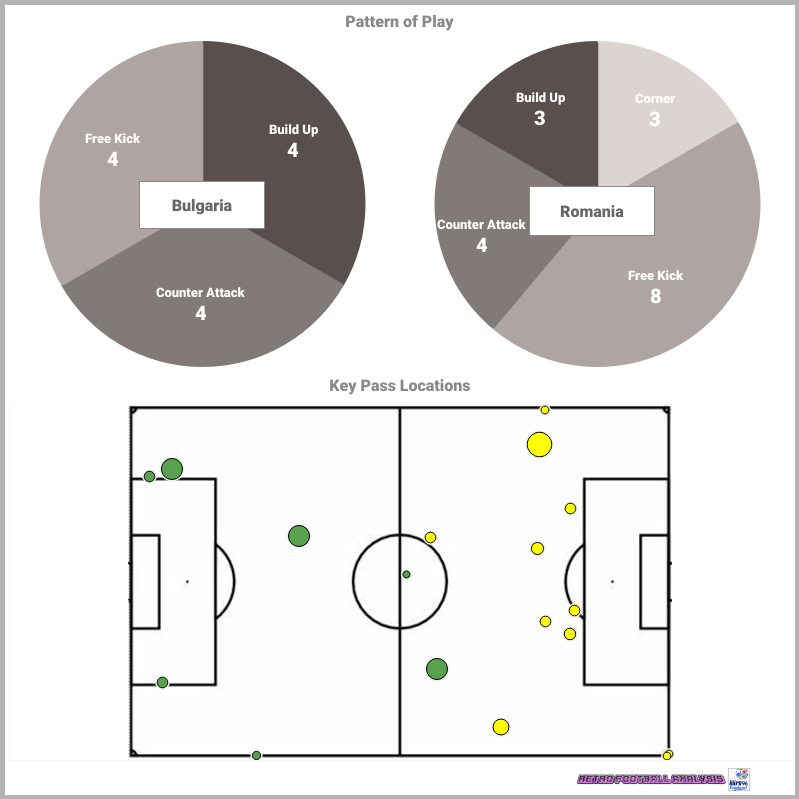
In Hagi Romania possess one of the best set piece takers in the world, however their reliance on set plays is starting to overshadow what a quality possession-based team they are. The way they progress the ball up the field through the thirds, most of the time with relative ease, is extremely impressive. With that said when play does reach the final third it often results in a speculative effort from over 25 yards, which often defeats the purpose of progressing the ball in such a structured manner. The best example of this came from Radiciou’s involvement, which was far superior than the first game. He operated as a false 9, dropping into spaces in midfield to find quick combinations with central midfielders, which opened up spaces for runners in behind him to penetrate Bulgaria’s back line. Quite often when play had then broken the Bulgarian midfield and Romania had found space entering the final third, there was no slide pass or quick entry into the box, it was met with a 30 yard effort that Mihaylov was then equal to.
Bulgaria’s early goal shaped much of their approach thereafter, however the quality of goal’s creation should not be missed. A lovely defence splitting move from the back into midfield and then onto Stoichkov showed Bulgaria’s quality on the ball, and how they would have been prepared to do things had the game stayed even. After the goal they sat off Romania and tried to condense the central space, leaving Stoichkov, Kostadinov & Penev always primed for an attacking transition. Bulgaria’s two biggest chances of the match would come from quick counter attack play, and its something that lends itself to a system that lacks any genuine width higher up the field.
Where Chances are Created
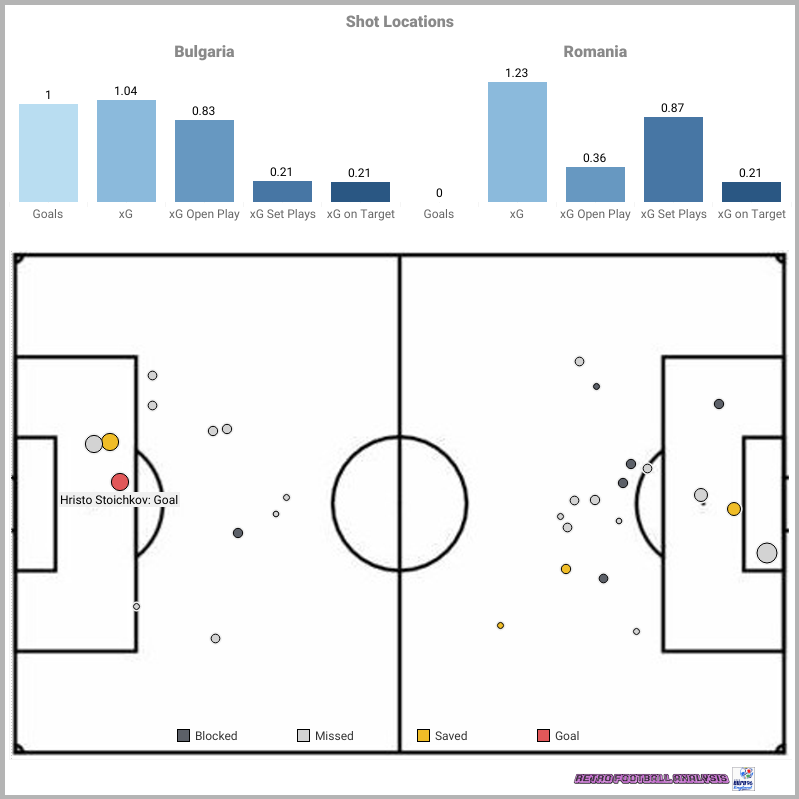
The harsh realities of the match are best illustrated in that from 30 combined attacks (between the two sides) only 5 would hit the target (2 for Bulgaria & 3 for Romania). Both sides have the ability to get themselves into good chances, but its turning them into genuine goal scoring opportunities that consistently trouble both sides.
This is best illustrated in looking at Romania’s 18 attacks and Bulgaria’s 12, with each recording 4 shots inside the box. Further to this Bulgaria would see two of these attacks hit the target (1 saved & 1 goal), whereas Romania would only connect one on target (Saved). Another layer to this is the xG on target comparison, with both sides recording 0.21 from their respective xG scores. While this may seem reasonable on the surface, Romania’s set plays accounted for 70% of their overall chance creation, which in reality is a free hit at the target from close range, but from 30 yards + (which a number of them were) then your requiring something special. Bulgaria on the other hand would record 80% of their xG from open play, which naturally brings a far tougher task in converting chances on target.
Who Created Chances
Bulgaria’s best statistical attacker was a very close run race, as there wasn’t one player who vastly out performed the best. Hristo Stoichkov gets the nod as he bagged the winning goal, however it would be the only one of the three attacks he had that did hit the target, the other two were free kicks from distance that both missed the frame.
Gheorghe Hagi was once again Romania’s best statistical attacker, mainly for the reason he is a one man shooting machine that will take aim wherever he finds himself on the field. He would have 5 attacks in total, two of which working the keeper, giving himself an xG score of 0.24 (24% chance of scoring). He would also be involved in 4 other attacks where he would set up a teammate, with one of these attacks ending up as a big chance (Free Kick to Prodan who missed a header at the back post).
Match Predictor
Using our very own Retro Football Analysis Match Simulator, we use the probability rating of each attack to calculate the odds of the matches outcome. Here are the results we got back.
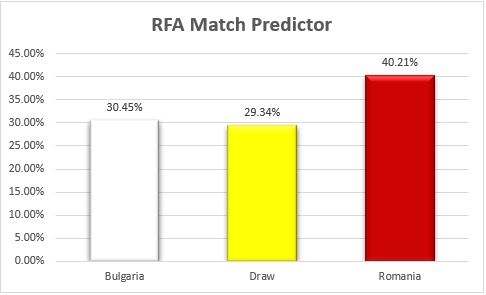
Our verdict:
Romania just edging this one by 10%, probably due to higher volume of attacks and the big chance that Prodan missed. It’s one of the higher draw ratings that we’ve saw in this series, which shows us how even the match really was from a statistical perspective.


